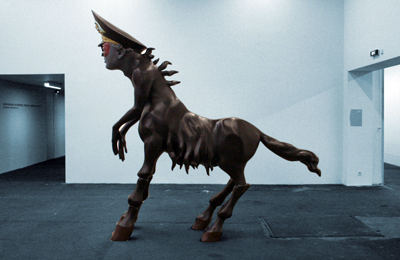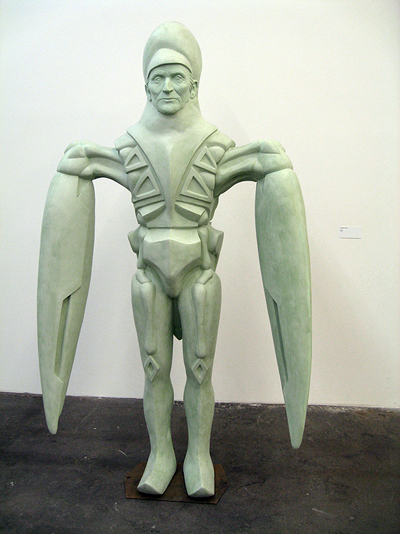
As a brief follow up to this recent post regarding Miss Jackson’s freakatude, let us ruminate on the April cover of BackBook magazine. Here she’s caged and dressed in latex by Polymorphe, House of Harlot, and Syren. Inside she’s snarling from behind some Very Serious headgear.

The BlackBook article describes this Matthew Rolston shoot and tells of “codpieces, feather ticklers, steel pelvic thrusters relieved of their phallic attachments, barbed cowhide whips are fanned out alongside some kind of automaton skull with a full set of human teeth and gums” here. Oh Janet.
Related articles on Coilhouse
Posted by Zoetica Ebb on March 27th, 2008
Filed under Fashion, Fetish, Photography, Uber | Comments (5)
The Tyrell Corporation’s shiver-inducing slogan was “More human than human”. Powerful, yes, but Boston Dynamics will not be outdone! “The Leader in Lifelike Human Simulation” leaves no room for speculation – you want the best, you go to Boston Dynamics, buster.

The video you are about to watch is of BigDog – a rough terrain canine simulator so powerful and elegant, it might make you fall in love and prove a cute thing doesn’t need a fluffy tail, big eyeballs [or a head for that matter], or a LOL-caption to be adored.
BigDog is powered by a gasoline engine that drives a hydraulic actuation system. BigDog’s legs are articulated like an animal’s, and have compliant elements that absorb shock and recycle energy from one step to the next. BigDog is the size of a large dog or small mule, measuring 1 meter long, 0.7 meters tall and 75 kg weight. BigDog has an on-board computer that controls locomotion, servos the legs and handles a wide variety of sensors. BigDog’s control system manages the dynamics of its behavior to keep it balanced, steer, navigate, and regulate energetics as conditions vary.
– Boston Dynamics
Sit back and enjoy. At 00:39 is an impressive kicking demo. Keep watching, as this mecha-pup slips on ice and catches itself just like a real animal, but better. Carrying a load of 340 lbs it manages to keep from falling and soldier on until the mission is complete.
[kml_flashembed movie="http://www.youtube.com/v/W1czBcnX1Ww" width="400" height="330" wmode="transparent" /]
D’aww!
Posted by Zoetica Ebb on March 21st, 2008
Filed under Advertising, End of the World, Technology, Uber | Comments (27)
Prosthetics are hot! That’s how I’ll console myself if I ever lose my hand in a terrible accident. I picture a long-fingered, razor-nailed chrome hand for everyday wear; a sleek jeweled hand with fingertips that project light (or film!) for the evenings; and for special occasions, I want a sock puppet that’s also a flamethrower. In my toolkit, I would also like to have something Ye Olde. Ideally I’d love to get my remaining hand on the following, eloquently written up for us by guest blogger David Forbes (aka Coilhouse commenter ampersandpilcrow). – Nadya

Götz Von Berlichingen had a problem. It was 1504 and, at the tender young age of 24, the plundering knight, mercenary and all around bastard had the upper part of his right arm torn off in a cannon blast. As someone who made his living off war and already had a sizable enemies’ list, Götz needed his killin’ hand.
So he got another one. Made of iron.

However, this was no crudely shaped hunk of metal — it was a mechanical masterpiece, centuries ahead of its time. The iron hand not only allowed Götz to return to battle, but later helped lay the foundation for modern prosthetics. Complete with articulated fingers, spring action and an array of levers and buttons, the hand allowed a degree of control that’s stunning even today. Fitted with it, Götz could do the following:
Posted by David Forbes on March 12th, 2008
Filed under Medical, Museum, Personal Style, Uber, War | Comments (35)
Andreas Hofer is s German-born artist that specializes in nightmares. Unlike much of the spooky-cute stuff on the art scene today, Hofer’s bizarre work actually makes me uncomfortable the way I wish more art could.

While Hofer works with all types of media, of particular interest to me are his sculptures. Almost toy-like, their scale exaggerated and subject matter not without humor, they are remarkably imposing and unsettling. So much so that I’m tempted to actually pinch myself to ensure lucidity.

Part of “Reich”, Acrystal, silicone, 2006
Most perfectly innocent objects can be terrifying when magnified, but Andreas’ strongpoint is twisting recognizable imagery in simple, potent ways that make the viewer cringe. He distorts things as nightmares would. This doesn’t seem to curb my desire to have his various beasts guarding my future compound – their design is just that appealing!
Many thanks to Jerem for the tip. Click below for more from Andreas Hofer.
Posted by Zoetica Ebb on February 29th, 2008
Filed under Art, End of the World, Sculpture, Uber | Comments (10)

Now this is über.
The taxidermist/sculptor behind this piece, sovaldi Lisa Black, has also created a wind-up baby crocodile with working gears. I want one as a pet! [By way of Warren Ellis and Porphyre]
Posted by Nadya Lev on February 20th, 2008
Filed under Art, Industrial, Sculpture, Taxidermy, Uber | Comments (10)
[kml_flashembed movie="http://youtube.com/v/jDQPVXUegPs" width="400" height="330" wmode="transparent" /]
But DAF do. Let this German electropunk duo’s clicky beeps entrance into a world [or at the very least a basement] of mechanized taxidermy, dusty porcelain, cracked papier-mâché and moth-bitten lace. Here, sterile minimalism and granny frills co-exist in harmony, somehow.
George Harrison’s “Set on You” got nothing on this billow-shirted, leather-trousered alchemy of pop. Perhaps he was somehow inspired by it?
Posted by Zoetica Ebb on February 20th, 2008
Filed under Industrial, Music, Silly-looking types, Surreal, Uber | Comments (4)

Artist Zdzislaw Beksiński is best known for his immense, obsessively detailed paintings of catastrophic landscapes, surreal humanoid figures and afflicted nudes. Born in 1929, he grew up in southern Poland, then traveled to Krakow to study architecture where he subsequently spent several miserable years working as a construction site supervisor. His work from that era is primarily photography and sculpture.
In his mid thirties, Beksiński shifted his focus to painting large, purely abstract pieces on wooden boards (he preferred wood to canvas). Eventually, their form and structure became more straightforward and he entered a self-proclaimed “fantastic period” reminiscent of Bruegel, Ernst or Bosch, and drawing comparisons to his Swiss contemporary, H.R. Giger.

Beksiński’s post-apocalyptic vision, much like Giger’s, is uniquely disturbing owing in part to a highly developed architectural eye. His manipulation of scale and manic overworking of texture is ingenious. Overwhelmingly huge structures rise up from dust or empty desert. Sinewy figures cavort under ominous skies.
Posted by Meredith Yayanos on December 22nd, 2007
Filed under Architecture, Art, End of the World, Horror, Sci-fi, Surreal, Uber | Comments (60)

I didn’t even know there was such a thing as industrial music when I stumbled onto Janet’s Rhythm Nation 1814 film in my pre-teens, but I knew that I’d made a very important discovery. Later there would be the mix tapes and the radio shows that exposed me to my favorite music in its true form, but until then, isolated in suburbia and still learning English, Janet’s video was my first glimpse into the aesthetics of my favorite musical genre.
Having re-watched Rhythm Nation today, I have come to a very important conclusion: Janet Jackson is even more ÜBER than I initially thought. Here’s why:
- The uniforms! God, the uniforms. Those gloves with the riveted metallic plates? Hot.
- “We are a nation with no geographic boundaries, bound together by our beliefs.” NSK State, anyone? Laibach, take note: Janet beat you to it by 4 years.
- The precise, mechanical dancing that looks like military formations puts the type of industrial dancing that you see at today’s clubs to shame.
- The entire clip takes place in a steamy factory that recalls Test Dept’s Total State Machine.
- Despite the strong percussion and electronic elements, I’d be pushing it if I claimed that this awesome song was industrial. But you know what? Janet created this socially-conscious record on her terms, in the face of a record company pressuring her to only sing about love and relationships. Who knows what this could have been, had there not been that pressure at all?
Posted by Nadya Lev on October 26th, 2007
Filed under Dance, Faboo, Film, Industrial, Music, Sexuality, Stroke Material, Uber, Uniform | Comments (15)













